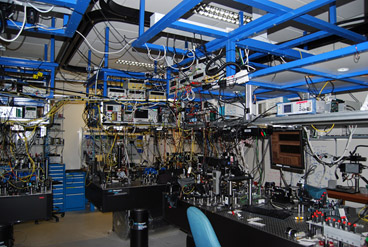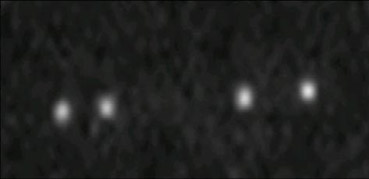Highlights
Experimental precision ahead of theory in measurements of Barium

An entire lab full of optics and electronics is employed to create, control and measure Barium ions.

The ions live undisturbed inside a glass cell from which almost all of the air has been removed to create a near-perfect vacuum.

A string of ions, ready for measurement.
All the apparatus that fills the laboratory of the Microtraps group at the Centre for Quantum Technologies — three heavy metal optical benches densely packed with lasers, lenses, mirrors and above them shelves full of electronics — has been put into service to produce and probe single ions of Barium. The results, measurements of the 'hyperfine' structure of 137Ba+, are accurate beyond all previous measurements; they even exceed the precision of theorists' calculations.
"What's important for me is that it's the first demonstration that we can do these types of measurements to this level of precision" says group head Murray Barrett, who is a CQT Principal Investigator and Assistant Professor at the National University of Singapore.
The work was carried out with group members Nicholas Lewty, Chuah Boon Leng and Radu Cazan, and external collaborator B K Sakhoo from the Physical Research Laboratory in Admedabad, India. The results are published in the 10 September issue of Optics Letters.
These experiments are a stepping stone not only to performing other precision measurements — highly accurate determinations of atomic properties have been important for tests of fundamental physics and in applications such as atomic clocks — but also to using Barium as a component for quantum computing.
Having mastered control of a single Barium ion for these experiments, Murray and his team want to try storing quantum bits (qubits) in two Barium ions and applying a logic gate to them. Ions so far appear one of the most promising systems for quantum computing, setting the record of 14 entangled qubits.
The hyperfine structure of an atom or ion is the splitting of the electronic energy levels caused by the magnetic field of the nucleus. By measuring this splitting in the energy levels of 137Ba+, the team deduced the ion's magnetic dipole moment, electric quadrupole moment, and magnetic octupole moment. These moments describe the shape of the nuclear electromagnetic field.
The new dipole and quadrupole measurements reduced 30-fold the uncertainty attached to the previous best experimental values for these quantities. The measurement of the octupole moment of 137Ba+ is a first, and it's the most accurately determined octupole moment of any element to date.
Achieving such precision meant chasing down every source of uncertainty in the lab — including the tiny leakage of light from lasers turned 'off' by not-quite-perfect optical switches, which the team realised was shifting the ion's energy levels. To counter this problem, the team introduced a second switch after the first.
The experimental results could prove a test for theory, since the measurements' precision now exceeds that of the theoretical predictions. "Theorists who do these calculations can take note of what we're doing," says Murray. "If their calculations don't agree with our results, there's a problem."
The uncertainty in the theoretical predictions is not attached to the underlying principles, but to the way the calculations are performed. The complexity of simulating the many strongly interacting particles in atoms (137Ba+ has 55 electrons, 56 protons and 81 neutrons) means that simplifying assumptions must be made in calculations. It is these assumptions the experimental results can help to check.
For more details, see "Spectroscopy on a single trapped 137Ba+ ion for nuclear magnetic octupole moment determination", Optics Express 20, 21379 (2012); arXiv:1205.6908.







